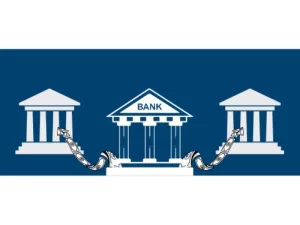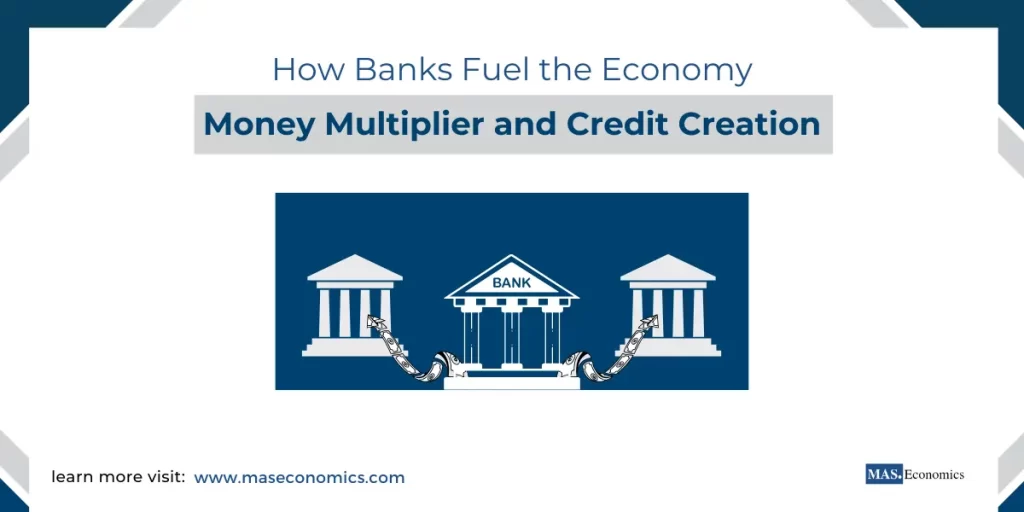In the modern financial system, banks are at the center of creating money and boosting economic growth. How do they do this? Primarily through two crucial mechanisms: the money multiplier and credit creation. These concepts aren’t just technical jargon; they are at the core of how economies expand and maintain financial stability. Whether you are curious about how money flows into an economy or why banks are vital to economic health, this guide will take you through the details of the money multiplier, credit creation, and the role banks play in fueling growth.
The Money Multiplier Explained
The money multiplier is an essential concept in understanding how banks influence the money supply. It represents the ratio by which the money supply changes in response to a change in the monetary base, which consists of currency in circulation plus reserves held by banks.
Imagine the money multiplier as a way to illustrate how a single dollar deposited into a bank can grow into many dollars circulating within the economy. The formula for calculating the money multiplier is:
Where \( Mm \) represents the money multiplier, \( M \) is the total money supply, which includes currency in circulation and bank deposits, and \( H \) stands for high-powered money or the monetary base.
Essentially, the money multiplier demonstrates how banks can turn a dollar in reserves into several dollars of money supply.
Let’s break it down further. Banks keep a portion of deposits as reserves, as required by regulations (known as the reserve requirement ratio), and lend out the remainder. When these funds are lent out and redeposited in banks, the process repeats, leading to multiple rounds of lending and deposit creation. This is why a relatively small initial increase in the monetary base can lead to a much larger increase in the total money supply.
Consider a simple example: Suppose the reserve requirement is 10%. If you deposit $1,000 into your bank, the bank keeps $100 as a reserve and lends out $900. That $900 can then be deposited in another bank, which keeps 10% and lends out $810, and so on. The multiplier effect shows how money “multiplies” as banks lend out their deposits, thereby increasing the overall money supply in the economy.
Key Formula for the Money Multiplier:
Where \(c\) is the ratio of currency to deposits, \(r\) is the reserve requirement ratio, and \(e\) is the excess reserves ratio. The money multiplier (\(M_m\)) depends on these ratios, which indicate how much banks hold back versus how much they lend out.
Credit Creation by Commercial Banks

Banks are often described as creators of money through credit creation. Essentially, banks create money by lending more than what they receive in primary deposits, thereby multiplying the available credit in the economy. When banks give loans, they are essentially creating deposits. The amount of credit that banks can create depends largely on their cash reserve ratio (CRR) and the behavior of depositors.
How Does Credit Creation Work?
Primary Deposits
When an individual deposits cash into a bank, the bank records this amount as a primary deposit. This cash forms the base that allows the bank to make loans.
Cash Reserve Ratio (CRR)
A portion of these deposits must be held as reserves—this is the CRR. Suppose a bank receives $1,000 and the CRR is 10%. The bank keeps $100 in reserve and has $900 available for lending.
Lending and Derivative Deposits
The bank lends the remaining $900 to a borrower, who then spends the money. When the money is spent, it will likely be redeposited in another bank, which, in turn, keeps a portion in reserve and lends out the rest.
This cycle of lending and redepositing can continue multiple times, creating what is known as derivative or secondary deposits. This is the essence of credit creation.
Mathematical Representation of Credit Creation:
Where \(\Delta D\) represents the net change in demand deposits due to an initial change in primary deposit (\(\Delta P\)), and \(r\) is the cash reserve ratio. This series represents how money multiplies as banks continuously lend and redeposit funds.
Limitations of Credit Creation:
Although banks have significant power in credit creation, there are limitations. For one, banks must always maintain a portion of their deposits as reserves, and the extent of their lending also depends on the willingness of customers to take loans and deposit funds. Furthermore, the central bank’s monetary policy can restrict or expand a bank’s ability to lend, such as by changing the CRR or through open market operations.
The Money Multiplier and Economic Stability
The money multiplier is not only an illustration of how money grows but also a mechanism that central banks monitor closely. Changes in the reserve requirement ratio directly affect the multiplier and, therefore, the supply of money. For example, if the central bank raises the reserve requirement, banks can lend out less, which shrinks the money supply. Conversely, lowering the reserve requirement can significantly expand credit availability.
Banks, by creating credit, effectively increase the money supply. This increase can boost aggregate demand, influencing economic growth, employment, and inflation. Therefore, credit creation by banks is a powerful driver of economic activity, but it must be managed carefully to avoid overheating the economy or triggering inflationary pressures.
Credit Creation in a Competitive Banking Environment
Banks do not operate in isolation. In a competitive banking environment, credit creation is influenced by the behavior of all banks within the system. Each bank’s actions influence the overall amount of money and credit available in the economy. Suppose Bank A loans out $1,000. That money will likely be deposited into Bank B, which then also lends a portion of the amount, creating a cascading effect across the entire banking system. This interlinked credit expansion process is the foundation of a functioning banking system.
However, the competitive environment also brings certain limitations. If a large number of borrowers fail to repay their loans, banks face liquidity problems that may lead to a credit crunch. Additionally, regulatory policies such as changes in CRR or interest rate policies influence how aggressively banks can expand credit.
Linking Credit Creation and Money Supply
It’s important to understand how money supply, credit creation, and economic policy are interconnected. Money supply in an economy is often measured by aggregates such as M1, M2, or M3, which include different types of money—from physical currency to various forms of deposits. The credit multiplier plays a significant role in determining these aggregates.
For example, the aggregate M1 includes currency in circulation and demand deposits. A large part of these deposits comes from the credit created by commercial banks. Therefore, policies that affect the money multiplier directly impact the total money supply in the economy.
The central bank, through its monetary policy, can influence the extent of credit creation by setting interest rates and reserve requirements. For instance, a lower interest rate makes borrowing more attractive, encouraging banks to lend more, which ultimately expands the money supply. Conversely, higher interest rates dampen borrowing and credit creation, slowing down money supply growth.
Conclusion
Understanding the money multiplier and credit creation is essential for grasping how economies grow and stabilize. The money multiplier effect means that a relatively small reserve can support a much larger amount of money circulating in the economy. By lending out funds, banks don’t just provide loans—they effectively create money. This ability to create credit allows banks to fuel economic growth, promote investment, and boost consumption.
However, this process also needs careful monitoring and regulation. Without proper control, excessive credit creation can lead to economic instability, inflation, or financial crises. Policymakers must balance fostering growth through increased money supply while ensuring that inflation and financial stability are kept in check.
FAQs:
How does the money multiplier work in the banking system?
The money multiplier illustrates how an initial deposit in a bank leads to multiple rounds of lending and deposit creation, expanding the money supply. Banks lend out most of their deposits, keeping only a portion as reserves. These loans, when redeposited, continue to circulate, generating further deposits and loans, thereby amplifying the overall money supply.
What role does the reserve requirement play in the money multiplier?
The reserve requirement determines the portion of deposits that banks must hold and cannot lend out. A higher reserve requirement reduces the amount available for lending, shrinking the money multiplier. Conversely, a lower reserve requirement allows banks to lend more, expanding the money supply.
How do changes in the money multiplier impact economic stability?
The money multiplier directly influences the money supply, which affects aggregate demand, economic growth, and inflation. If the multiplier increases due to lower reserve requirements or increased lending, the money supply expands, potentially boosting growth but also increasing inflation risk. Conversely, a shrinking multiplier can slow down economic activity by reducing credit availability.
What is the relationship between credit creation and money supply?
Credit creation occurs when banks issue loans beyond their primary deposits, leading to the creation of new money. The amount of credit banks create contributes significantly to the broader money supply, as deposits generated from loans form part of aggregates like M1 and M2, which represent different forms of money in the economy.
How do banks create money through credit creation?
Banks create money by lending out a portion of their deposits. When these loans are spent and redeposited in other banks, those banks also keep a reserve and lend out the rest. This process of repeated lending and depositing amplifies the initial amount, effectively increasing the money supply.
What limitations affect banks’ ability to create credit?
Banks face several limitations, such as the reserve requirement ratio, liquidity constraints, and regulatory policies from central banks. Additionally, credit creation depends on the willingness of borrowers to take loans and depositors to re-deposit funds. Central banks also influence credit creation through interest rate policies and open market operations.
How do central banks control credit creation and the money multiplier?
Central banks control credit creation by adjusting the reserve requirement ratio, setting interest rates, and using open market operations. Lowering reserve requirements or interest rates encourages lending and expands the money multiplier. Raising these requirements has the opposite effect, reducing the money supply and curbing inflationary pressures.
What happens when credit creation leads to excessive lending?
Excessive credit creation can lead to an overheated economy, triggering inflation or asset bubbles. If borrowers default on loans, it can cause liquidity problems for banks, leading to a credit crunch. Policymakers must carefully monitor credit growth to prevent economic instability or financial crises.
How do competition and interbank lending influence credit creation?
In a competitive banking environment, the actions of one bank influence the entire system. When one bank lends money, the funds are typically redeposited in other banks, amplifying credit creation. However, competition also increases risks, as multiple banks may aggressively lend, leading to overextension and potential financial instability.
How are money supply aggregates (like M1 and M2) connected to credit creation?
Money supply aggregates, such as M1 and M2, include different forms of money—from physical currency to various types of deposits. A significant part of these deposits arises from credit creation by banks. The extent of credit creation directly impacts these aggregates, influencing the overall money supply and economic activity.
Thanks for reading! Share this with friends and spread the knowledge if you found it helpful.
Happy learning with MASEconomics




